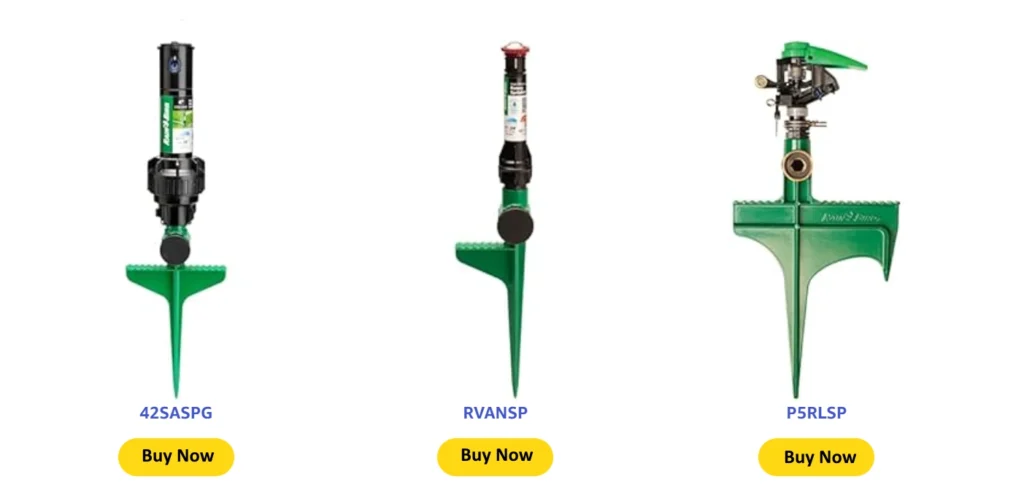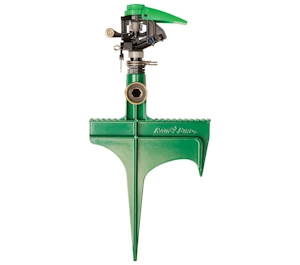When my Rain Bird sprinkler stopped last summer, I thought something was broken. But most problems are easier than they seem. If your Rain Bird sprinkler isn’t working, don’t worry. The fix might be as simple as cleaning a clogged head or checking the timer.
I’ve seen dry spots and quiet zones in my own yard. Over time, I’ve learned what to look for. Sprinkler problems can often be solved in just a few steps.
I’ve spent years fixing sprinkler systems. Now, I’ll show you the same steps I use. Let’s figure it out together. Your lawn—and your water bill—will thank you.

Table of Contents
1. Common Reasons Your Rain Bird Sprinkler Is Not Working
If your Rain Bird sprinkler isn’t working, don’t worry. Most times, the fix is simple. I’ve run into many of these problems myself. Once you know what to check, it’s easy to get things working again.

a. Water Supply Problems
First, check the water source. Make sure the main valve is open. Sometimes it gets shut off by accident.
In colder areas, homes often have a shutoff valve for winter. I’ve forgotten to turn mine back on in spring more than once. If your system won’t run in early spring, that’s a good place to look.
b. Controller Problems
Next, check the controller. Make sure it has power. A tripped breaker or a dead battery can stop it.
Also check the settings. I’ve seen zones get deleted or the schedule changed by mistake. One wrong button can stop the whole system.
c. Wiring or Solenoid Trouble
If you hear a click but no water, it might be a wiring problem. Or the solenoid (the part that opens the valve) might be bad.
Once, one of my zones didn’t turn on. A wire had rusted underground. If you have a multimeter, you can test each solenoid and wire. Replacing a solenoid is pretty easy. Just shut off the water first.
d. Sprinkler Head Problems
Heads can clog or get stuck. I’ve broken a few with my lawnmower. If the spray is weak or uneven, dirt might be blocking the nozzle.
Low pressure can also mean a clog. One time, I found a pebble in the nozzle. A quick rinse fixed it. Sometimes it really is that easy.
2. How to Troubleshoot a Rain Bird Sprinkler That’s Not Working
Fixing a sprinkler system sounds hard, but it’s not. Here’s how I go step-by-step to find the problem.

a. Step-by-Step Troubleshooting Checklist
- Start with the controller – Make sure it’s on and the screen works.
- Check the water valve – Make sure it’s fully open.
- Test each zone by hand – See which ones work.
- Check wires and solenoids – Look for loose wires or broken parts.
- Look at each sprinkler head – Clean nozzles and check for damage.
Tools I Use:
- Multimeter (to test wires and solenoids)
- Flathead screwdriver (to open valve boxes)
- Needle-nose pliers (to remove debris)
- A pin or small brush (to clean spray heads)
These tools are simple but have helped me fix most problems in one afternoon.
b. Tips from My Own Yard
One summer, I saw a dry patch in the grass. One head wasn’t popping up. It was stuck from a bit of mud. I used a toothbrush and warm water—easy fix.
Another time, a zone didn’t work at all. I found a wire that a squirrel had chewed. I fixed it with waterproof wire nuts. It’s worked fine ever since.
Keeping a few extra sprinkler heads and tools in the garage can save time—especially in summer when grass dries out fast.
3. When Only One Zone or Sprinkler Head Isn’t Working
Sometimes, one zone or head doesn’t work—but the rest is fine. This has happened in my yard more than once. The good news? It’s often a simple fix.
Start by finding the problem.
Use the controller to test each zone. If one doesn’t turn on, it may be a wire, solenoid, or a setting in the controller.
If it’s just one sprinkler head, check it up close. It could be clogged, cracked, or stuck. I’ve even had bugs crawl in and block it.
Quick checks for common issues:
- Clogged nozzle: Dirt, sand, or grass can block it. Take the nozzle off and rinse it. A pin or toothbrush helps.
- Stuck head: If it won’t pop up, try wiggling it gently while the water is running. Mud can hold it down.
- Bad solenoid or wire: If a whole zone won’t run, the solenoid may have gone bad. I had to replace one last spring. It took me about 10 minutes.
- Controller setting: One time, a zone was turned off in the settings. Nothing was broken—it was just off by mistake.
If you live in the U.S. and have clay soil or heavy storms, you might get more clogs. I flush out my system every spring to help prevent that.
4. Rain Bird Controller Not Working? Here’s What to Do
If your controller won’t turn on—or acts strange—don’t worry. Most problems are simple.

Start with the basics:
- Is it plugged in?
- Is the screen on?
- If it uses a battery, try a new one.
Once, my screen went blank. I thought it was dead. But the GFCI outlet had tripped. I hit the reset button, and it worked again.
Next, check the settings.
Zones might get removed or the schedule might change. Check start times, days, and how long each zone runs. I once set mine to water every day at midnight. No wonder the grass was soaked!
Other easy fixes:
- Try a reset. Many controllers have a reset button or a factory reset option. Write down your schedule first.
- Use manual mode. If manual watering works, the controller is sending signals. The problem is likely in the schedule, not the hardware.
- Wi-Fi problems? If you use a smart Rain Bird, power surges or router issues can knock it offline. Reboot it or refresh the app. That often fixes it.
5. Should You Repair or Replace Your Rain Bird Sprinkler?
I’ve asked myself this many times—especially with older systems. The answer depends on what’s wrong and how old your system is.
When to repair:
- Only one or two heads are broken or clogged.
(New heads are cheap. I keep a few extras on hand.) - A solenoid or wire is bad.
(These parts are easy to swap out.) - The controller has a minor glitch.
(Try a new battery or reset first.)
When to replace:
- The system keeps breaking after repairs.
- Your controller is very old and can’t use smart features.
- You see big leaks or lots of heads failing.
If you’re in the U.S. and using an older system, a smart controller might be worth it. I switched last year and love adjusting mine from my phone. Some areas even offer rebates.
If you’re not sure about wiring or valve boxes, call a local pro. But if you’re good with tools, most fixes are simple and can be done in a weekend.
6. Preventive Maintenance Tips
I’ve learned this the hard way—waiting until something breaks can lead to dry grass and big repair bills. But a little care each season can keep your Rain Bird system running well all year.
Do a spring check-up.
Before I use the system each spring, I test each zone. I turn them on by hand and check that every head pops up and sprays right. If you live in a cold state like I do, make sure your winter shutoff valve is back on.
Clean the sprinkler heads.
Even if your lawn looks okay, heads can still collect dirt or grass. I take mine off and rinse them in warm water. A toothbrush works well on stuck dirt. One time, I found a spider nest in one—that explained the weak spray!
Flush the system yearly.
If you live in a spot with clay soil or hard water (many U.S. areas do), it’s smart to flush the lines once a year. I do this in early spring. It takes less than 30 minutes and helps prevent clogs.
Check the wires and battery.
Each spring, I check the battery in my controller. I also look in the valve boxes for chewed or loose wires. One year, I found a wire that a mouse had chewed during winter. Now I check every time.
Small checks can save big money.
These quick tasks might seem small, but they’ve saved me from costly repairs. One broken solenoid caused a soaked patch and raised my water bill. If I had caught it sooner, it would have been a five-minute fix.
Read More: Orbit Sprinkler Not Rotating?
Conclusion
If your Rain Bird sprinkler isn’t working, don’t worry. Most problems are small—like a clog, a bad setting, or a weak battery. I’ve seen all kinds of issues, and most were easy to fix.
The key is to stay calm, take it one step at a time, and be ready to get your hands a little dirty. With a screwdriver, a pin, and some patience, you can fix most things yourself.
Still stuck? It might be time to call a pro—or leave a comment below. I’ll do my best to help!
FAQs for Rain Bird Sprinkler Not Working
Why is my Rain Bird sprinkler not working at all?
It may not be working because of a clog, a valve problem, or low water pressure. Check each part to find the issue and fix it fast.
What should I do if my Rain Bird sprinkler won’t rotate?
If it won’t turn, dirt or grass might be blocking it. Clean the head well. If that doesn’t work, check for broken parts.
Why won’t my Rain Bird sprinkler turn on automatically?
It may not turn on because of a wrong setting, a dead battery, or a bad timer. Check the power and review your schedule.
How do I fix low water pressure in my Rain Bird sprinkler?
Low pressure can come from leaks, clogs, or running too many zones at once. Try fixing leaks and run fewer zones at a time.
Can a Rain Bird sprinkler stop working after rain or a power outage?
Yes. If you have a rain sensor, it may stop the system. A power cut can reset your timer—check your settings to be sure.

